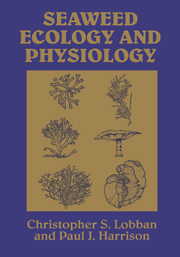Book contents
- Frontmatter
- Contents
- List of contributors
- Preface
- 1 Morphology, life histories, and morphogenesis
- 2 Seaweed communities
- 3 Biotic interactions
- 4 Light and photosynthesis
- 5 Nutrients
- 6 Temperature and salinity
- 7 Water motion
- 8 Pollution
- 9 Seaweed mariculture
- Appendix: Taxonomic classification of algae mentioned in the text
- References
- Index
3 - Biotic interactions
Published online by Cambridge University Press: 18 December 2009
- Frontmatter
- Contents
- List of contributors
- Preface
- 1 Morphology, life histories, and morphogenesis
- 2 Seaweed communities
- 3 Biotic interactions
- 4 Light and photosynthesis
- 5 Nutrients
- 6 Temperature and salinity
- 7 Water motion
- 8 Pollution
- 9 Seaweed mariculture
- Appendix: Taxonomic classification of algae mentioned in the text
- References
- Index
Summary
The environment of an organism includes both biotic and abiotic (physiochemical) factors. Communities of marine organisms encompass not only the seaweed communities but also the animal communities, of which the benthic grazers and their predators are most important to seaweed ecology. Thus, the biotic interactions of seaweeds include not only competition with other seaweeds (both within and between species) and with sessile animals but also predator–prey relations at several trophic levels; the mix of such interactions will change as the individual changes with age and environmental history.
Biotic interactions are complex, and their study often requires large-scale and long-term observations and manipulations in the laboratory, as well as in the field; see this series of minireviews: Olson and Lubchenco (1990), Carpenter (1990), Paine (1990), Maggs and Cheney (1990). Two quotations from reviews that are both methodological and philosophical will serve to introduce two major topics of this chapter – competition and herbivory: “The objectives of studies of competition include, first, a demonstration that competition occurs, second, identification of the mechanism by which it occurs, and, third, determination of the importance of competition to the ecology of species or communities” (Denley & Dayton 1985). “Approaches and solutions to the problems and measurement of herbivory are strongly influenced by the nature of the questions being asked. Many algal–herbivore interactions have significance in an ecological context only when examined by a wholecommunity approach, often involving experimental manipulation of seemingly-unrelated parameters” (Vadas 1985).
- Type
- Chapter
- Information
- Seaweed Ecology and Physiology , pp. 99 - 122Publisher: Cambridge University PressPrint publication year: 1994
- 1
- Cited by



